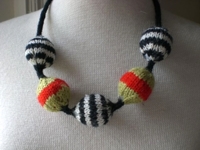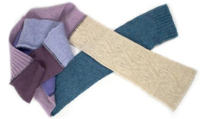I find this necklace from knitted beads cute – I can imagine it easily with summer socks wool or simply with different yarn rests :)
Search Results for: pom pom
Roman Pear Soufflee
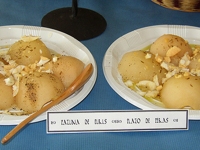
Recently I’ve seen a documentary about the Romans and I found the dishes they presented interesting.
There I learned that a certain Apicius wrote a cookbook that you still can get today (see links below).
Searching on I found this picture here and I found that this Roman Pear Soufflee looks delicious.
So I looked how to prepare it and really found an English recipe. They said in the film that the Roman dishes were a haphazard mixture of sweet, hearty and hot from today’s perspective.
And can you believe it? They put Garum even in the pear soufflee where I first thought that it would be sweet!
Even so I want to find the ingredients and give it a try ;-)
Links:
Picture: patina de piris
Recipe: PATINA DE PIRIS (Pear Soufflè) (English)
Recipe: Patina de piris (Birnenauflauf) (German)
Cookbook of Apicius:
Apicii librorum X qui dicuntur De re coquinaria quae extant (Latin)
Cookery and Dining in Imperial Rome (English)
English Wikipedia entry for ‘Apicius’
German Wikipedia entry for ‘Apicius’
Here at unikatissima: Garum
Garum
Lately I read several historical novels about Caesar and Cicero – and at some point they all mention Garum – the notorious fish sauce which the old Romans seem to have poured over nearly everything (I understand that it was the ancient ketchup ;-)).
That’s why I wanted to know whether the recipe is still known.
It is.
And if you will excuse me I stick to ketchup.
;-))
Links:
Garum: Fish Sauce Made in Pompeii (English)
Liquamen, garum (Rezept) (German)
Sweater Scarf
Once I found an instruction on how to make a scarf from felted old sweaters but the website doesn’t exist anymore.
The photo is from the website, click to enlarge.
That’s how they did it:
- Wash sweaters from 100% wool (mohair works fine, too) with some laundry detergent.
- Felt in dryer.
Felting makes the fabric so dense that it doesn’t unravel when cut. - Cut stripes from the sweaters in the width you want the scarf to be.
The lengths will vary depending on the part of the sweater where you cut the piece.
In the instruction they used mainly the arms. - Eventually simply sew the pieces together, whether with a sewing machine or by hand.
The seam can be used as a decorating element. - The scarf can subsequently be embellished: with buttons, felted flowers, beads, pom-poms, fringes, embroidery and so on.
In fact I would like to have a cardigan-kind garment made with this technique, no scarf.
Therefore I went to several second hand stores to look for wool sweaters but found mostly sweaters from artificial material which don’t felt.
But I stay tuned ;-)
Links:
The original website that doesn’t exist anymore
Here at unikatissima: Entries with the tag ‘felting’
Fringed Buttons
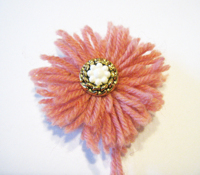
I found the fringed buttons very nice. But they are done with ready-made fringes which I don’t have at home.
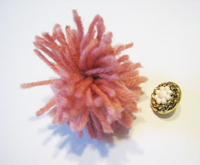 Therefore I made a kind of pom-pom from wool rests and put my button inside there and although I find the button awful kitschy I quite like the combination ;-))
Therefore I made a kind of pom-pom from wool rests and put my button inside there and although I find the button awful kitschy I quite like the combination ;-))
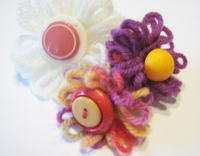 Of course you can as well tuck a Crazy Daisy under the button ;-))
Of course you can as well tuck a Crazy Daisy under the button ;-))
Links:
Fringe-y Goodness
Here at unikatissima:
Crazy Daisy Ring
Crazy Daisies
Crazy Daisies II
